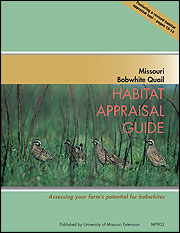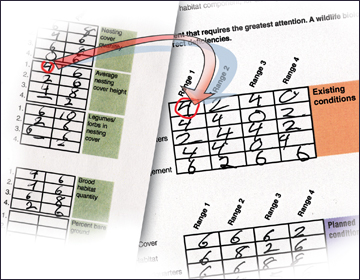Assessing your farm's potential for bobwhites
Northern bobwhite quail (Colinus virginianus) have long been a favorite of landowners and hunting enthusiasts across Missouri. Besides being a desirable wildlife species for recreational hunting, bobwhite quail also play an important role within forest, grassland and agricultural ecosystems.
Quail eat plant and weed seeds and consume a variety of insects. They also serve as prey for many predators. Because of their role in the food chain, quail are an important indicator of ecosystem health. The species is representative of a community of wildlife that requires early-successional habitats.
More specifically, bobwhites prefer habitats that have recently been disturbed. The resulting plant community includes grasses and legumes, a wide variety of broadleaf plants, annual weeds, and brushy cover, all closely interspersed across the farm.
Bobwhites are found throughout Missouri. However, their population level at any given time is directly related to land use patterns, management practices and weather. Historically, quail populations have increased and declined as a result of natural factors, as well as the land use and management activities of humans. Early land-use practices and farming methods, such as sharecropping and the use of fire, created a patchwork of small fields that provided ideal quail habitats.
Over the past 30 years, bobwhite quail populations have significantly declined across Missouri. Modern farming tends to use more intensive cultivation practices, makes use of herbicides and insecticides to a greater degree and requires larger equipment. These advanced farming methods have encouraged the removal of edges and field borders, resulting in larger field sizes. Pastures have also been planted to monocultures of grasses such as tall fescue. Tall fescue tends to grow aggressively, and this further reduces the overall habitat quality for bobwhites in many areas.
On many farms, weedy and brushy fence lines, field borders and draws have become dominated by smooth brome, tall fescue and mature trees. Large expanses of woodlands made up of trees with closed canopies do not provide suitable habitat for bobwhite quail.
Your property may have the potential to provide better habitat, but the quality will vary from poor to excellent depending on many land-use factors. Habitat is also influenced by annual disturbances such as disking, prescribed fire, grazing, row cropping and timber harvests.
As a landowner, you have a great opportunity to improve bobwhite quail habitat on your property. By understanding the habitat needs for bobwhites, you can begin to identify the habitat components that may be missing on your farm, as well as appraise the quality of the habitat that may already present. Once this has been accomplished, you can apply the appropriate management practices to improve the habitat for bobwhite quail on your property.
Assessing quail habitat
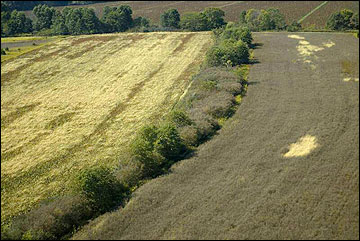 Figure 1
Figure 1
Evaluating your farm's potential for bobwhites is the first step to improve quail habitat.
This appraisal guide provides a process for you to evaluate the suitability of a particular area of land (such as cropland, pasture, grassland or forest) on your farm for bobwhite quail. It is designed so that you can inventory and analyze existing habitat conditions (see Figure 1). The guide also serves as a tool to help you identify the habitat requirements that are in the shortest supply (called limiting factors ) that potentially limit quail numbers on your property.
Identifying these limiting factors is an important step in determining the appropriate management alternatives that need to be implemented to improve the carrying capacity , or the capability of the habitat to support a population of bobwhite quail. In addition, the appraisal guide will assist you in evaluating your chances of success and help you decide whether additional investment in bobwhite quail management is needed.
Managing for bobwhite quail can require a significant amount of time and financial commitment. You will find that there are often land-use trade-offs involved that need to be considered as habitat management decisions are made. To succeed with your habitat management goals, it is important to understand that bobwhites need different habitat types throughout the year. Bobwhites require early-successional plant communities dominated by herbaceous vegetation (such as grasses, annual weeds and legumes), interspersed with grain crops, brushy cover and open stands of timber.
Determining your farm's potential for bobwhites
 Figure 2a, top, and 2b
Figure 2a, top, and 2b
Landowners interested in improving habitats for bobwhite quail can make initial management decisions based on a chosen conceptual home range size. Aerial maps can be used to outline and assess these areas on your farm.

Bobwhite quail typically restrict daily activities to a home range that varies in size depending on the kind, amount, condition and interspersion of required habitat components. All habitat requirements for the bobwhite quail must be found within this area, referred to as the home range.
The size and shape of this area are determined by the limits of how far the animal can travel and the overall quality of the habitat that exists within the home range.
Home ranges for bobwhite quail are not marked by permanent boundaries, nor are they the same from one year or season to the next. Because of this, research has suggested that landowners interested in improving their farm for bobwhite quail make initial management decisions on the basis of the species' conceptual home range and the desired intensity of management. The conceptual home range is the area selected by the landowner for bobwhite quail management. This process allows you to arbitrarily set boundaries around the limits of movement for the bobwhite. This also allows you to work on one home range at a time to improve quail habitat. In theory, you should be able to produce at least one covey for each conceptual home range if all limiting factors are addressed.
Identifying conceptual home range areas (see Figures 2a and 2b) is an important first step as you begin to appraise and evaluate the habitat quality for bobwhites on your farm. Working with a conceptual home range of less than 15 acres may not be cost-effective. Likewise, working with a conceptual home range larger than 80 acres does not provide adequate habitat conditions that are in close proximity to one another. In other words, one covey per 15 acres is about as good as you can practically manage quail habitat, and one covey per 80 acres is about as large as you can stretch out the habitat conditions. The quality of habitat within a conceptual home range is determined by the condition of the habitat components within the specified area.
Bobwhite quail use all plant successional stages of vegetation, from recently disturbed openland to mature forest. However, bobwhites are primarily a species requiring edge habitats and early- to mid-stages of plant succession. Excellent seed producers and indicators of early-successional habitats attractive to bobwhites are
- Ragweeds (Ambrosia spp.)
- Pigweeds (Amaranthus spp.)
- Foxtail grasses (Setaria spp.)
- Panic grasses (Panicum spp.)
- Tick trefoils (Desmodium spp.)
- Smartweeds (Polygonum spp.)
Habitat quality generally declines as perennials and woody plants replace shade-intolerant annuals and clump grasses. However, patches of woody plants and shrubs provide valuable protective cover.
In general terms, ideal bobwhite quail habitat should be made up of the following:
- About 50 percent of the area in annual weeds, legumes, and minimum or no-till row crops
- About 30 percent of the area in grasses
- About 20 percent of the area in shrubby, brushy cover
Note
Addressing the limiting factors on your property may not immediately restore a population of quail. If you have a small property surrounded by large areas of fescue, mature forest or row crops, quail populations may be slow to increase. This will tend to reduce all habitat ratings.
Improving habitat for bobwhites
One goal for managing habitats for bobwhites is to make each square foot of a management area, or home range, usable throughout the year. Habitat is usable if it fits the habits and physical needs of the bird. Providing habitats that are usable simply means creating and managing cover to which bobwhites are adapted.
Cover types need to be mixed together, or interspersed, throughout the home range. The proper arrangement of these habitat patches (food and cover) is important because of the bobwhite's relative low mobility and the need for open, bare ground conditions. Bobwhite quail spend a great deal of time walking, feeding, loafing and roosting directly on mineral soil. Their daily movements are often restricted to a home range size of 20 to 40 acres. Depending on the season bobwhites may indeed roam over a larger area. However, research indicates that a covey seldom uses an area larger than 100 acres in size. Keep in mind that the size of the home range is directly dependent on the quality and quantity of habitat, which can vary throughout the year.
Under certain conditions, bobwhites concentrate their activity around food and cover patches that are less than 50 feet apart. Recent research has found that bobwhite quail seldom travel more than 70 feet from woody escape cover during the winter. This demonstrates the importance of having brushy cover close to available foods during the winter months.
As mentioned earlier, size of the bobwhite's home range varies according to the quality and quantity of habitat within a particular area. Although it is common for individual birds to move further distances during fall and spring, the habitat components necessary for a covey of quail must be met within their home range.
The average bobwhite population density on intensively managed areas is about one covey per 15 acres. In the Midwest , the carrying capacity of the habitat for quail rarely exceeds one bird per acre under the best habitat conditions. During the fall (when populations are typically at their highest), the average covey is made up of about 10 to 12 birds.
Using the habitat appraisal tool
The habitat appraisal tool PDF outlines the process for evaluating the quantity and quality of habitats and for identifying the limiting factors that may exist on your farm. The values represent the general quality of the habitat and identify the factors that limit the bobwhite quail population within the selected conceptual home range.
The appraisal tool allows you to select the rating that best describes the existing land use and cover conditions. Steps four through seven outline the habitat appraisal process and help you record ratings of your farm.
The following procedures describe the method to inventory existing habitat conditions and calculate the limiting factor values. It is suggested that the appraisal be conducted during the growing season, particularly as the habitat evaluation will be based on the kinds, amounts, condition and arrangement of the plant community. However, habitat can be evaluated year-round as long as the user pictures growing season conditions.
Procedures for habitat appraisal
The following steps outline the procedures for conducting habitat appraisal.
Step 1
Determine goals and objectives
First, determine goals for your property and the intensity of management you are willing to commit to. You may ask yourself several questions to determine the goals and objectives for your property, such as the following:
- Do you wish to intensively manage your property for bobwhite quail?
- Is the bobwhite a secondary species of concern, after white-tailed deer or a combination of other wildlife species?
- Do you wish to integrate bobwhite quail management practices with ongoing agricultural production?
Step 2
Estimate time and cost
Next, determine the practicality of managing for bobwhite quail on your property and the amount of time and money you are willing to invest. For example, if a large percentage of your property and the surrounding area is dominated by tall fescue pastures, mature forest land, or large crop fields, a greater time and financial commitment will be required to make necessary habitat improvements for bobwhite quail.
Step 3
Select the best locations for assessing habitat
Select locations on your farm that have the greatest potential for improving bobwhite quail habitat. It is best to select areas that represent a conceptual home range for bobwhite quail on your property. The size of the home range will be predetermined, based on the intensity of management you wish to employ and your desired population goals.
For example, you may set a goal of having one covey per 15 acres, one covey per 40 acres, etc., on your property. It is important to realize that the smaller the home range, the more intensive the management becomes.
Conceptual home ranges that you select may be square, rectangular, triangular, or any other shape that is practical to appraise and manage (see Figures 2a and 2b). The conceptual home range may consist of one field, or more often will cross field or land use and cover boundaries.
Several home ranges may also be superimposed over the entire farm or area of interest. Any portion of your property may be appraised by evaluating one or more of these conceptual home ranges. The remainder of the farm does not have to be appraised at all, or may be appraised by evaluating the habitat for another species.
Step 4
Examine habitat within the conceptual home ranges
In this step, examine the habitat found within the selected home ranges. It is important to ensure that all required habitat components are present. If any component is missing, record a “0” value as that component's quantity requirement rating on the evaluation tool.
This means that the habitat is unsuitable for bobwhite quail unless that habitat component is provided. Some requirements may be filled by more than one component. For example, herbaceous plants (annual weeds, grasses or legumes) may fulfill both food and brood habitat requirements.
- Ratings
Ratings for the various habitat criteria range from 0 (poor) to 10 (excellent). Each habitat criteria has one to three variables, and each variable has different levels of management that can be evaluated and applied.
Step 5
Evaluate the condition of required habitat components
Next, evaluate the habitat components by matching habitat conditions with the ratings for the various requirements. These are also listed on the evaluation tool. Specific instructions are contained in the next section and on the appraisal tool.
Step 6
Determine the limiting factor value for each habitat component
Based on your assessment and rating of the various habitat criteria you can identify the requirement that has the lowest value for each of the habitat components necessary for bobwhite quail within each home range.
Habitat component limiting factor value = the requirement with lowest rating value for each habitat component
Step 7
Develop a wildlife management plan
Finally, assess the habitat requirements that are limited or missing, and develop a management plan that addresses bobwhite quail habitat needs.
Habitat requirements
The following section provides a brief summary of the food and cover requirements for bobwhite quail. These include nesting cover, brood-rearing cover, protective and escape cover and important foods. In addition, the criteria for each of the cover requirements are described in more detail.
Nesting cover
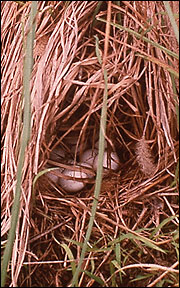 Figure 3
Figure 3
Bobwhite prefer to nest in clumps of grasses from the previous year's growth.
Bobwhites begin nesting in Missouri after covey break-up occurs in April. However, most nesting will begin in May with peak hatching in mid-June with a smaller peak in July. Either perennial or annual warm- and cool-season grasses from the previous season provide nesting cover for early season nesting (Figure 3).
Nesting cover typically consists of grasses at least boot-high or around 12 inches to conceal quail. Small clumps of grass with last year's grass residue present are preferred. Nesting cover should be open clumps of grass, which can conceal the nest site, near open ground to allow chick movement after hatching. Radio-tagged birds in a north Missouri study chose nest sites with an average of under 10 percent grass composition, while an Iowa study found nests that had an average grass composition of 69 percent at the nest location. Nesting cover should be heavily disturbed once every two or three years. This promotes growth of legumes and weedy vegetation and helps create open ground conditions.
Grasses must also be located in close proximity to brood-rearing habitat. Most nests are located 50 to 70 feet from an opening or edge. Dense vegetation and thick litter on the soil surface restrict the movement of small chicks and inhibit foraging. Thus, disturbance on a two- to four-year cycle is necessary to maintain nesting cover. As the time since disturbance increases beyond three years, litter accumulates, grasses become too dense, and quality of nesting declines.
The following criteria, outlined on the evaluation tool, are necessary for quail nesting cover:
1. Nesting cover quantity within the home range
Nesting cover is defined as an open grassy area where the plant community includes the following:
- Warm-season bunch grasses such as big and little bluestem, broomsedge, indiangrass, switchgrass, sideoats grama, or others that are a height of at least 12 inches at maturity
- Other cool-season perennial grasses, provided that the grass stand has been recently disturbed (at least once out of the last three years by light disking or burning).
- Low-growing woody cover such as poison ivy and blackberry, with sparse ground cover and nearby herbaceous material.
The same areas that provide food or brood habitat may serve as nesting cover. At least 30 percent of the habitat within the bobwhite's home range should be composed of grassy/herbaceous vegetation. When the optimal home range size is being considered (15 acres), at least 4.5 acres (or 30 percent of the area) should be composed of grassy/herbaceous vegetation for optimal nesting cover.
2. Nesting cover height
Cover height depends on management practices such as grazing, mowing or prescribed burning. Nesting cover conditions occur where at least 12 inches of grass stubble height remains. Land that is hayed typically does not have the residual cover necessary to initiate a nest.
3. Distance to edge
Quail nest research in Missouri has shown that quail prefer to nest within 50 feet of an edge. Similar research in Iowa showed a preference for nesting within 75 feet of edge. Edge is, generally considered, the boundary between another habitat type, such as nesting cover and a cropfield, covey headquarters, pasture or woodland. The more edge created within nesting cover, the more opportunity will be presented for quail nesting. Strip disking, patch burning, food plots or development of covey headquarters areas are some examples of how to create edge within nesting cover. When considering nesting cover that has been broken up by strips of crops, disking or food plots, use the average distance from the center of each nesting cover strip to edge. Nesting habitat provided in strips such as field borders must be wide enough to prevent a predator from easily finding birds or nests. Nesting strips should not be less than 30 feet wide. The wider the field border or nesting strip, the better the chances of a quail nest producing a brood of birds with the optimum width being around 150 feet.
Some of the best nesting cover existed in Conservation Reserve Program fields, which were planted to a mixture of orchardgrass and annual lespedeza. During planting, the seed was broadcast and the lighter grass seed did not fly as far as the lespedeza seed. The resulting fields were narrow strips of lespedeza alternating with narrow strips of orchardgrass. Likewise, radio-tagged quail on conservation areas in northern Missouri chose nest sites, which were characterized by widely scattered clumps of grass, surrounded by weeds and blackberry vines, instead of sites with a solid stand of grasses.
Brood rearing cover
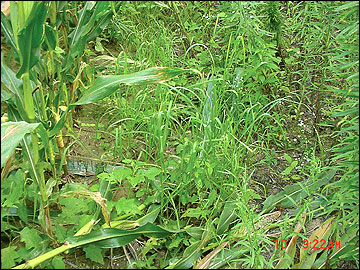 Figure 4
Figure 4
Fallow crop fields, annual weeds, and legumes provide excellent brood-rearing habitat.
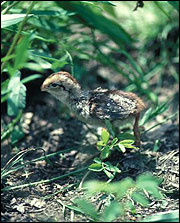 Figure 5
Figure 5
Annual weeds provide an abundance of insects needed for quail chicks.
Brood rearing cover can be different from the cover used for nesting or it can be one in the same. Brood rearing cover is characterized by a plant community made up of legumes and annual weeds. These habitats are typically found in areas that have been left fallow one to two years after a soil disturbance (see Figure 4). Insects are the most important food item for nesting hens and quail chicks. A fallow crop field (such as corn or grain sorghum) that has been planted the previous year is a good example of this type of habitat. The annual weeds in such fields provide an abundance of insects needed for rapid chick development and are often used by broods as feeding areas.
Only minimum- or no-till crops contain enough insects, ants and spiders to sustain a quail chick. Tilled crops with heavy use of herbicides do not provide enough food to sustain a brood of quail chicks. Tilled crops or food plots should have little herbicide used in order to promote weedy plant growth to attract insects for the quail chicks. In addition, research has shown that disked plots planted to millet, wheat and legumes such as red clover and lespedeza provide quality brood rearing cover. Some legumes such as red clover or ladino clover can be planted too thick, which provides little opportunity for quail chick use. Areas that have been burned also promote this type of patchy vegetative cover that attracts insects. These areas are often called bugging grounds. Good brood habitat consists of plants that provide overhead cover that conceals bobwhites from predators, while remaining relatively open at ground level for easy chick movement (see Figure 5).
The following criteria, also listed on the evaluation tool, are important for brood habitat:
1. Quantity of brood habitat within the home range. Brood habitat is defined as any area that provides food and cover for the survival of quail chicks during the time of brood rearing (May 15-Sept. 15). About 40 percent of the bobwhite's home range should consist of brood habitat (legumes, annual weeds, fallow fields, minimum or no-till crop fields). When the optimal home range size is being considered (15 acres), at least 6 acres (or 40 percent of the area) should be composed of brood habitat.
The same areas that provide either food or nesting cover may also qualify for brood habitat.
2. Percent bare ground
Open conditions at the soil surface are critical for optimal brood rearing habitat. At least 25 to 50 percent of the area should consist of bare ground conditions at the soil surface. Fields with less than 5 percent bare ground typically have vegetation that is too thick for broods to use.
3. Screening cover
Screening cover is defined as the overhead canopy of herbaceous plants (approximately 6 inches in height) which provides protection for quail chicks during their foraging activity.
Protective and escape cover
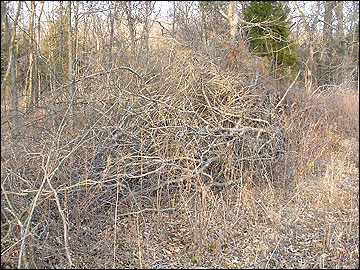 Figure 6
Figure 6
Protective cover helps bobwhites escape hawks, owls, foxes, cats and other predators.
Protective (escape) cover is used by bobwhites throughout the year and is necessary for eluding predators such as hawks, owls, foxes, and house cats (Figure 6). Stands of overgrown shrubby cover, as well as stands of grass and weedy areas open at ground level, are also typically used. Protective cover must persist throughout the year, especially during cold weather when thermal protection is needed, and during the summer for protection from heat and sun.
The lack of escape cover is often identified as a limiting factor on many farms in Missouri . Escape cover should be available in patches that are at least 30 feet by 50 feet in size. It is also extremely important that food sources be available that are adjacent to protective cover.
Escape cover typically should not have a canopy of larger trees over it, because quail prefer not to have their flight path blocked and to flush up through several layers of canopy. In native plant communities such as savannas, woodlands or glades, which may have a ground layer of shrubs, grasses and forbs, the overhead canopy of trees is acceptable to quail. This is because the tree canopy is usually high enough to allow quail to flush and fly between the shrubby layer and the overhead tree canopy. Woodlands or savannas, that are not properly managed, may develop a midstory canopy of smaller trees over time, which will block the quail's flight path and make the area unusable for quail again.
Areas that provide protective cover are called covey headquarters because coveys of quail spend a large part of the day loafing in this type of habitat. The following criteria, also listed on the evaluation tool, can be considered when measuring or improving covey headquarters:
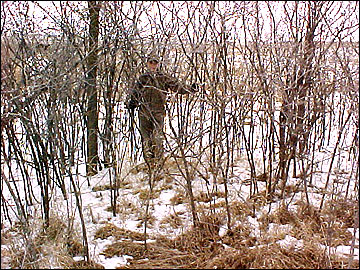 Figure 7
Figure 7
A covey headquarters area consists of patches of woody shrubs that provide overhead cover and open access at ground level.
1. Quantity of covey headquarters within the home range
Covey headquarters consist of woody shrubs/low-growing stemmy trees (3 to 12 feet tall) or other cover types such as downed trees that are dense enough to form a canopy (Figure 7). This provides protection from the elements and predators. These areas must also be open beneath the canopy to permit quail movement. A minimum size for a covey headquarters should be approximately 1500 sq. ft., or 30 feet by 50 feet.
The distribution of these habitat types across the farm is extremely important. Research conducted during winter months in Missouri found that the average distance between known quail locations and woody cover was only 70 feet. In other words, the usable space in a particular field or area consists of a relatively narrow band next to woody cover.
Two critical factors that need to be determined include the size of a particular field and the amount of shrubby cover in close proximity to the area. Consider an area about the size of a football field (300 feet in length and 160 feet wide). The entire field is theoretically usable if both sidelines are lined with shrubby cover. If the field is substantially larger, there may be areas in the middle that are more than 70 feet from shrubby cover. This space would be unusable by bobwhites. Placing a covey headquarters in this unusable space increases the carrying capacity of the habitat for bobwhite quail. A guideline measurement for spacing between covey headquarters is about 150 feet.
In general, 10 to 20 percent of the bobwhite's home range should be made up of brushy or shrubby cover. With a conceptual home range size of 15 acres, three acres (or 20 percent of the area) of shrubby habitat need to be available to optimize the protective cover within the area. Covey headquarters should be distributed throughout the home range (as described earlier) to improve habitat conditions.
2. Covey headquarters composition
Covey headquarters should be composed of trees and shrubs with low canopies (3 to 12 feet tall), shrub thickets, briars and bramble thickets are all examples. Edgefeathering and downed tree structures are also examples of covey headquarters.
Low-growing shrubs such as plums, blackberries, sumacs, sassafras, false indigo, shrub lespedezas, young pine plantations, dogwoods and buckbrush provide valuable protective cover that can be used throughout the year.
These types of cover provide the best protection because they are persistent over a number of years. Covey headquarters of tall weeds are not persistent unless steps are taken to maintain the weed patch from year-to-year.
Protective cover should also offer overhead protection, completely concealing quail from aerial predators, but relatively open at ground level to permit quail movement underneath.
Trees that have blown down or structures made from downed trees may be included only if the structures provide overhead protection and the ground cover beneath the canopy is sparse. Dense brush piles generally are not suitable covey headquarters because they are too thick and usually are not open beneath the canopy.
3. Density of the covey headquarters
Canopy closure should be measured by selecting a representative area of protective cover (the covey headquarters). This may be a single low-growing tree or shrub, but is usually characterized by a thicket or clump of shrubs. The minimum size of a covey headquarters is 1500 square feet. (at least 30 feet wide). Canopy closure at 3 feet in height is important, as this is the level that will provide adequate protection from predators or inclement winter weather. Shrubs that do not reach at least 3 feet in height are used little by quail. Canopy higher than 12 feet adds little value for covey headquarters. Record the combination of covey headquarters size and canopy closure that yields the highest possible rating value.
Imagine a volleyball thrown into the top of a covey headquarters. The ball should hit several branches and fall within the covey headquarters. If the canopy is too thick, the ball will roll off and away from the headquarters. If the canopy is too thin, the chances of the volleyball hitting a shrub are low.
Foods for bobwhites
 Figure 8
Figure 8
Seeds from annual weeds, legumes, grasses, shrubs, trees and crops, along with insects, provide foods for quail.
The diet of adult bobwhite quail consists of insects, seeds and fruits of annual weeds, legumes, grasses, shrubs, trees and cultivated crops (see Figure 8). Seeds are eaten throughout the year, but are heavily used during the fall and winter. Insects are high in protein and are eaten during the spring, summer and fall. Because of quail chicks' high dietary protein requirement, insects are their primary food item during their first few weeks of life. For purposes of habitat appraisal, only food plants are considered, assuming that the more diverse the plant life within the home range, the more insects as well as seeds and plant parts will be available year-round for quail foods.
The following criteria can be used to evaluate the capability of the habitat to provide food sources.
1. Measure food quantity
Fall and winter quail foods primarily consist of the seeds from a wide variety of plants (see the box on page 10). These food plants also attract insects that are beneficial for quail. Several criteria that should be considered when examining the habitat's potential to provide food for quail are categorized as follows:
- Very abundant
If 100 paces were taken in a representative portion of the plant community, 50 percent of the steps would strike an important quail food plant. - Abundant
If 100 paces were taken in a representative portion of the plant community, 30 percent to 50 percent of the steps would strike an important food plant. - Moderately abundant
If 100 paces were taken in a representative portion of the plant community, 10 percent to 30 percent of the steps would strike an important food plant. - Sparse
If 100 paces were taken in a representative portion of the plant community, less than 10 percent of the steps would strike an important quail food plant.
A single adult bobwhite quail consumes an average of 0.05 pound of food per day. A covey of 14 birds would consume 0.70 pound of food per day. Enough food must be available during the fall to last through the winter until the critical month of March. This means that about 130 pounds of food (0.70 lb per covey per day x 182 days = 127 lb) needs to be produced and available during this period.
Generally, this amount of food can easily be produced if native food sources are available. This can also be accomplished within a quarter-acre crop field or food plot if soil fertility and weather conditions are ideal or by idling a portion of a food plot to allow annual weed growth. However, this area would need to be larger if high populations of white-tailed deer are present.
At least 50 percent of the bobwhite's home range should be made up of habitats that provide food sources. By applying 50 percent to the optimum bobwhite quail home range size (15 acres) it can be determined that 7.5 acres of the area that provides available sources of food would be needed to optimize the bobwhite's food requirements throughout the year.
The same areas that provide either nesting cover or brood habitat may also qualify as habitat that provides food, assuming that the criteria for each requirement are met.
2. Food diversity
The major food groupings for bobwhites include annual weeds, legumes, grasses, grains and woody vegetation. Food plants are represented in this criterion when it is easy to observe their presence. More than 300 different food plants have been found in the diets of bobwhite quail in Missouri .
3. Food accessibility
Bobwhites secure most of their food on the ground or from the layer of leaves and stems on the soil surface. If seeds are to be found by quail, they must be seen on bare ground or in litter that is sparse and can be easily moved. If seeds drop on a thick mat of stems and leaves, they will fall to the bottom and become inaccessible. At least 50 percent of the area being evaluated should consist of bare ground conditions.
The following categories can be used to define plant litter conditions:
- Light plant litter
50 percent or more bare ground in food areas. - Moderate plant litter
30 to 50 percent bare ground in food areas. - Heavy plant litter
10 to 30 percent bare ground in plants areas. - Very heavy plant litter
10 percent or less bare ground in food areas. The area selected for estimating food accessibility should fall within the same boundaries and locations that produce the majority of the potential food sources.
Arrangement of habitat components
Bobwhites are an edge species that require a mix of grasses and herbaceous cover, agricultural crops, and brushy cover all closely arranged together. You can use aerial photographs to help evaluate the arrangement of habitats on your property. These can be obtained from your nearest USDA NRCS Service Center or from the MU CARES website.
The optimum arrangement of habitats, as outlined in the appraisal tool, includes the following:
- 30 to 40 percent grassland or early-successional stage forest (dominated by grasses and annual weeds) in 5- to 20-acre patches
- 40 to 60 percent early-successional grassland (high annual and perennial weed and legume component) or cultivated crop fields in 1- to 5-acre patches
- 5 to 20 percent brushy (shrubs or tree sprouts) cover in small patches
Woodland or forest habitat components are unnecessary if shrubs are present. The ranges above can be used to construct ratings for the various habitat requirement quantities.
Water requirements for bobwhites
Surface water is not essential for bobwhites, although it may be used if provided. Water needs are usually met by seeds, succulent herbaceous plants, insects, dew and snow. Surface water, such as ponds and streams, produces microhabitats that can provide green, succulent vegetation and insects during dry or unfavorable weather conditions.
Apply habitat appraisal to your farm
Note
To optimize quail habitat on your farm, you must address the lowest limiting factor score(s) under each habitat component in every conceptual home range.
The habitat appraisal process serves as a tool to help identify the habitat components that are in the shortest supply and will potentially limit quail numbers on your farm. The system for appraising habitat is used by matching the criteria ratings with the nearest match of existing land use and cover conditions, and calculating the necessary values for determining the habitat quality.
The habitat appraisal tool PDF. describes a method for inventorying existing habitat conditions, rating the habitat element criteria and calculating the habitat quality and limiting factor values. As the appraisal system is based primarily on the kinds, amounts, condition and arrangement of plants, it is suggested that the inventory be performed during the growing season. However, habitat can be evaluated year-round as long as one pictures growing season conditions.
Ratings for the various habitat criteria range from 1 (poor) to 10 (excellent). The number of ratings per criteria depend on the number of variables that can be practically measured and levels of management that can be practically applied. A scoring sample is located on page 15 of this guide.
Information obtained from the habitat appraisal provides a basis for developing a wildlife management plan for your property. The habitat appraisal will also provide a tool for making management decisions which benefit bobwhite quail, and will help you to enhance habitat to address current limiting factors.
Selected resources for bobwhite quail management
For more information on managing your farm for bobwhite quail, contact a natural resource or wildlife professional with the Missouri Department of Conservation (MDC), USDA Natural Resources Conservation Service (NRCS) or MU Extension.
Additional resources
- Wildlife Management for Missouri Landowners, third edition, published by the Missouri Department of Conservation.
- Quail Management, Missouri Department of Conservation
- Missouri Pheasants and Quail Forever
This guide was collaboratively developed by MU Extension, the Missouri Department of Conservation and the USDA Natural Resources Conservation Service and has been adapted from the Oklahoma Cooperative Extension Service publication Circular E-904, Habitat Appraisal Guide for Bobwhite Quail.
